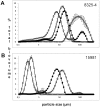Planktonic aggregates of Staphylococcus aureus protect against common antibiotics
- PMID: 22815921
- PMCID: PMC3399816
- DOI: 10.1371/journal.pone.0041075
Planktonic aggregates of Staphylococcus aureus protect against common antibiotics
Erratum in
- PLoS One. 2012;7(10). doi:10.1371/annotation/08d0f2a8-0c40-4a0c-b546-0025648e73f0
Abstract
Bacterial cells are mostly studied during planktonic growth although in their natural habitats they are often found in communities such as biofilms with dramatically different physiological properties. We have examined another type of community namely cellular aggregates observed in strains of the human pathogen Staphylococcus aureus. By laser-diffraction particle-size analysis (LDA) we show, for strains forming visible aggregates, that the aggregation starts already in the early exponential growth phase and proceeds until post-exponential phase where more than 90% of the population is part of the aggregate community. Similar to some types of biofilm, the structural component of S. aureus aggregates is the polysaccharide intercellular adhesin (PIA). Importantly, PIA production correlates with the level of aggregation whether altered through mutations or exposure to sub-inhibitory concentrations of selected antibiotics. While some properties of aggregates resemble those of biofilms including increased mutation frequency and survival during antibiotic treatment, aggregated cells displayed higher metabolic activity than planktonic cells or cells in biofilm. Thus, our data indicate that the properties of cells in aggregates differ in some aspects from those in biofilms. It is generally accepted that the biofilm life style protects pathogens against antibiotics and the hostile environment of the host. We speculate that in aggregate communities S. aureus increases its tolerance to hazardous environments and that the combination of a biofilm-like environment with mobility has substantial practical and clinical importance.
Conflict of interest statement
Figures








References
-
- Costerton JW, Stewart PS, Greenberg EP. Bacterial biofilms: a common cause of persistent infections. Science. 1999;284:1318–1322. - PubMed
-
- Brady RA, Leid JG, Calhoun JH, Costerton JW, Shirtliff ME. Osteomyelitis and the role of biofilms in chronic infection. FEMS Immunol Med Microbiol. 2008;52:13–22. - PubMed
-
- del Pozo JL, Patel R. The challenge of treating biofilm-associated bacterial infections. Clin Pharmacol Ther. 2007;82:204–209. - PubMed
Publication types
MeSH terms
Substances
LinkOut - more resources
Full Text Sources
Medical
Molecular Biology Databases

